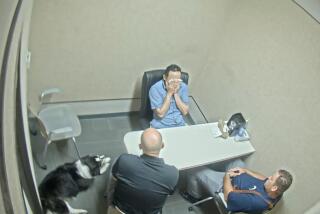Legal System Missed Chances to Hold Rogers : Crime: Swamped courts, packed jails helped suspected killer elude custody--most recently in Van Nuys.
As Glen Rogers graduated from routine assaults to alleged serial killings, the criminal justice system missed three chances to stop him, or at least slow him down, according to court records and interviews.
Miscommunications among police, overcrowded jails and backlogged courtrooms all contributed to Rogers’ ability to repeatedly elude authorities and avoid lengthy jail time during the last two years.
In his most recent slip through the cracks, Rogers could have been sent to Los Angeles County Jail in September for as long as 2 1/2 years for spousal battery and probation violation.
Instead, he was ordered by a Van Nuys court commissioner to serve two days in jail, pay a $100 fine, enroll in a domestic violence program and stay away from his girlfriend, Maria Gyore. Because of time he spent in jail waiting for the hearing, Rogers walked out of the courtroom a free man.
That was Sept. 1. Four weeks later, Rogers allegedly strangled another woman he met in a Van Nuys bar--33-year-old Sandra Gallagher of Santa Monica--before embarking on a lethal cross-country killing spree that authorities say spread to Mississippi, Florida and Louisiana.
“This guy should’ve been put away a long time ago,” Gallagher’s husband, Steve, said Tuesday. “He’s obviously one of those cases of the kind of people who shouldn’t be walking around.”
Said Harland Braun, a noted criminal defense attorney: “I think it’s time for the public to grow up. If they want tough law enforcement, they’ve got to pay for it and not cry when someone slips through the cracks like this.”
Rogers, 33, was captured Monday near Richmond, Ky., and remained there Tuesday while authorities from five states conferred on who will prosecute him first. Investigators also grappled with the question of whether four deaths might have been prevented had authorities in Los Angeles and elsewhere acted differently in their encounters with Rogers.
Police in Hamilton, Ohio, now say they were on to Rogers “right away” after he vanished in November, 1993, about the same time that his roommate, 72-year-old Mark Peters, was reported missing. Rogers had a long criminal record in his hometown, where he was known for a hair-trigger temper and violence against women, so he seemed a logical witness to question.
Then, on Jan. 10, 1994, investigators found Peters’ badly decayed body bound and hidden inside a rural Kentucky cabin belonging to the Rogers family. They were led there, according to one source, by one of Rogers’ brothers. Although the cause of death has yet to be determined, the discovery of the body in the Beattyville, Ky., cabin only affirmed detectives’ intent to question Rogers.
Los Angeles Arrest
Yet the drifter’s location remained unknown until the following summer, when he was arrested and jailed in Los Angeles County on unrelated charges. Noting that he was wanted for questioning in Ohio, Los Angeles authorities contacted Hamilton Police Detective James Nugent, who says he was prepared to fly to Los Angeles to interview Rogers about Peters’ death.
But Nugent’s trip was vetoed at the last minute by Hamilton’s chief of police, a department spokesman, Dan Pratt, confirmed, a casualty of concern that the interview might not be fruitful. Hamilton authorities also said they believed colleagues in Kentucky, where the body was found, were actively pursuing Rogers.
But about the same time, authorities in Kentucky dropped plans to charge the missing Rogers with an unrelated count of burglary, abandoning their own efforts to return him to their state.
“I couldn’t believe it,” Joan Burkhart, Peters’ daughter, said in a telephone interview. “I couldn’t get them to do anything. I talked to the chief of police here [in Hamilton] and the chief of police and detective in Kentucky. . . . I finally just gave up on it.”
In Los Angeles, Rogers was racking up new allegations of domestic abuse and other crimes. On June 6, Rogers attacked two men with a knife in his Hollywood apartment building, trapping one inside an elevator for several minutes with the knife held to his throat, police said.
Rogers pleaded no contest to charges of assault with a deadly weapon and was sentenced by Hollywood Municipal Judge Michael Mink to six months in jail and three years probation.
But Rogers served only 42 days. He was the beneficiary of a county work-release program aimed at freeing up space in overcrowded jails. Under the program, only the least dangerous convicts are supposed to be let out before they finish their terms.
Undersheriff Jerry Harper and Sheriff’s Sgt. Richard Spear noted that both of Rogers’ convictions were misdemeanors, making him eligible for the work-release program.
“People like this are being released early because we just don’t have the capacity,” Spear said.
“The most we can keep them in jail is about one-third of the sentence,” Harper said.
After his release July 17, an enraged and jealous Rogers caused so many frightening, drunken scenes at the Van Nuys lounge where Gyore worked as a bartender that she was fired in order to keep him away.
Then in late August, Rogers attacked Gyore again--throwing her and her belongings out of the Van Nuys apartment they shared and apparently causing her to seek legal recourse. The next day, Aug. 30, Gyore and her brother filed a complaint against Rogers at the Van Nuys Police Station and Rogers was arrested for spousal battery.
Once again, he pleaded no contest to the charge and because of his prior conviction, might have been returned to jail for one year on that charge. Rogers was still on probation for the Hollywood assault case, and a judge could have revoked his probation at that point and sent him back to jail for another 18 months, officials said.
But despite the record, Van Nuys Municipal Court Commissioner Rebecca Omens sentenced Rogers to two days in jail.
Omens would not comment Tuesday but told a reporter for KCBS-TV on Monday night that she did not remember the case.
“As a bench officer, generally you rely on court staff--the attorneys, the sheriffs--to bring to your attention anything unusual,” Omens was quoted as saying.
A Municipal Court spokeswoman, Marcia Skolnick, also declined to comment.
Michael Knight, presiding judge of the Van Nuys Municipal Court, said bench commissioners such as Omens hear an estimated 300 to 400 cases a day, leaving them with no choice but to rely on others for background checks and to red-flag anything serious.
“She’s a hard-working bench officer and does a lot of cases every day, and she’s committed to what she does,” Knight said.
‘Low-Level’ Violation
The prosecutor in the case might have missed the earlier conviction, said Richard Schmidt, supervisor of the city attorney’s office in Van Nuys, which handled the case. Schmidt declined to identify the deputy city attorney who handled the case, and said he did not know whether the commissioner was told about Rogers’ criminal record.
“It was a low-level violation in terms of the kinds of spousal abuses cases we get here,” said Schmidt, defending the outcome. Schmidt said the victim sustained a single bruise, and even with the probation violation, “it’s highly unlikely the court might have given him much more time in jail.”
The root cause of the tremendous caseloads is underfunding, Braun said.
“These cases have to be handled on a mass basis because we’re so crowded and underfinanced you’re going to have these kinds of cases slip through. The fact of the matter is you’ve got police departments that can’t afford it, and judges who don’t have time to look at it, and people locked up in overcrowded jails. It’s like the O.J. case: If you don’t want to pay for a modern scientific lab at the LAPD, you’re going to have a problem,” Braun said.
Gyore’s brother, Laszlo, says he was shocked by Rogers’ lenient treatment. “They just turned him loose, with no problem. I knew by the end of the month he would blow.”
Laszlo Gyore also maintains that he repeatedly called police at the Van Nuys station, as well as Deputy City Atty. Michael Duran, who prosecuted Rogers in the knife attack, to warn them of Rogers’ potential violence. His sister, meanwhile, had fled to their native Hungary for safety.
“I barely did anything else besides alarm people to do something,” he said. “And nobody paid any heed until we had five cadavers.”
At least one local authority was monitoring Rogers’ activities. Mink, the same Hollywood judge who sentenced him to six months in jail for the knife attack, revoked his probation last month and issued a warrant for his arrest after Rogers failed to appear at a probation violation hearing.
That was Oct. 25, when detectives say he was long gone from California and already alleged to be living with his next victim in Jackson, Miss.
* SUSPECT ARRAIGNED: Rogers pleads not guilty to Kentucky charges. A3
More to Read
Sign up for Essential California
The most important California stories and recommendations in your inbox every morning.
You may occasionally receive promotional content from the Los Angeles Times.






